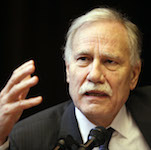
Tomorrow’s mobility: a paradigm shift for infrastructure
Tomorrow’s mobility will be cleaner, smarter and more versatile. Of course, when we say that, we picture driverless cars, connected and autonomous vehicles, more user-friendly mobility applications on our phones, etc.
Nevertheless, in order to achieve such a goal, transport infrastructure are also relevant, and will have to change too: not only because they are a support for this profound transformation, but also because they are an inherent part of it.
It goes without saying that the investment needs of transport infrastructure are colossal: roughly 130 billion euros per year in the EU are required (without even taking into account those related to maintenance).
How do we explain these enormous needs? One of the main reasons is a paradigm shift in our understanding of transport infrastructure: whereas previously, they were designed to allow vehicles to go from A to B, nowadays they also have to face and address a whole new set of issues.
Moreover, in the context of budgetary constraints, both at EU and Member State level, ensuring an appropriate and adequate infrastructural response to these issues constitutes a severe challenge.
Firstly, there is a need to tackle climate change. Currently, 72 % of transport CO2 emissions are coming from the road sector, a sector contributing for more than 25 % of the overall greenhouse emissions in the EU-28.
Transport infrastructure has a big role to play in reducing these emissions by two different, yet complementary approaches.
On one hand, by focusing on multi-modality and interoperability, and notably on a Modal Shift from road to rail (less polluting), both for passengers and freight which supposes developed, widespread and connected railway networks.
Shift2Rail is a successful initiative, put in place by the EU, in order to achieve this goal. On the other hand, for road transport, the expected rise of alternative fuels and electric vehicles is inseparably linked to the infrastructure and the deployment of charging stations.
Full of promise, and sometimes fantasy, these vehicles would drastically reduce emissions whilst favouring the production and injection of renewable energy into the grid, through dedicated infrastructure, and therefore increasing the resilience of our overall energy markets.
However, to spark an electric vehicle revolution, it must be compulsory to invest both in charging infrastructure and in the reinforcement of the electric network as well as interconnection capacities.
For too long, vehicles manufacturers have been too reluctant to produce alternatively-fuelled vehicles, due to a lack of charging points.
This self-reinforcing “serpent biting its own tail” circle has to end through substantial investment in adequate infrastructure. Thereafter, the deployment of clean vehicles and infrastructure will greatly contribute to meeting our environmental objectives and the improvement of public health.
Secondly, there is a need to preserve and strengthen our competitiveness. At EU level, this has been one of the first and oldest objectives in transport policy, and undoubtedly, one of its greatest accomplishments.
However, more has to be done in order to achieve the completion of the Trans-European Network in Transport (TEN-T), estimated to 1.5 trillion EUR.
The benefits expected are nevertheless numerous: facilitating cross-border connections, fostering greater economic, social and territorial cohesion, contributing to a more competitive economy while combating climate change.
In the context of intensified international competition, this is a vital aspect for the prosperity of our European economies.
Additionally, there is a necessity to ensure safer mobility across Europe. Infrastructure is evidently crucial in that regard the state of the roads people drive on has a huge impact on their safety which raises the question of the maintenance of infrastructure.
Moreover, in order to increase our competitiveness and our security, the integration of new transport technologies in infrastructure is mandatory (5G, broadband, communication vehicles to infrastructure etc.).
The rise of connected and autonomous vehicles, facilitated by sufficient infrastructure, will improve the European mobility system as a whole, making transport safer, more accessible and sustainable.
As it stands, the stakes are high, the amount of work needed is significant, and the budget is not sufficient, at both European and National level.
Whereas political and budgetary uncertainties are strong – which has a negative impact on private investment many questions still remain, such as the delicate issue of the maintenance of infrastructure.
At the same time, decision-makers should keep in mind that making the environmental transition in transport socially acceptable is not an innate thing, but requires a globally and coherent approach, as well as a democratic debate.
In that regard, the recent events in France are a stark reminder of it, a special focus and care should be given to the most vulnerable people both in social and geographical terms (peripheral, rural areas).
If we want these populations to participate in this transition, the burden has to be shared equitably and the connectivity of all our territories guaranteed.
The future of our European Mobility and more broadly, of our European societies is at stake.
We need to decide and act accordingly now, to put this paradigmatic shift into practice by investing today in the infrastructures of tomorrow.
Considering the urgency of the situation, every effort made in that direction counts.
As Camus wisely said, “real generosity towards the future lies in giving all to the present”.




